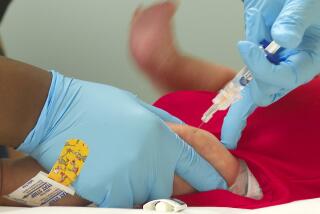Nation’s Syphilis Rate Worst Since 1949, Despite Drug Cure
- Share via
WASHINGTON — The nation’s syphilis rate last year was the highest since 1949 and represented a 75% increase from 1985, federal health officials reported Thursday.
“This is like going back to the pre-penicillin years,” said Dr. Allyn Nakashima, referring to the drug that cures the sexually transmitted disease.
Contrary to nationwide trends, the rates in several cities, including Los Angeles, actually declined. However, the number of syphilis cases in Los Angeles was so high previously that the rate still exceeded the national average.
Nakashima, an expert with the federal Centers for Disease Control in Atlanta, said that the huge nationwide increase is “frustrating, since we have a drug that works.” She said that the social stigma from the disease represents a major treatment problem.
The incidence of syphilis in 1990 was 20 cases per 100,000 population, compared to nearly 29 cases per 100,000 in 1949. In the intervening decades--until about 1986--the rate ranged between 4 and 12 per 100,000, the CDC reported in its Morbidity and Mortality Weekly Report.
Nakashima said that the number of cases in the 1940s was so large because of massive screening programs instituted after penicillin’s introduction.
Orange County bucks the national trend, reporting a syphilis rate that is far lower than the national average and has declined for the past four years.
Last year, 107 new syphilis cases--a rate of 4.4 per 100,000 population--were reported in Orange County, the lowest rate in at least 10 years, according to data provided by the county Health Care Agency. The rate in 1989 was slightly higher, at 5.0, with 115 cases reported.
The county’s all-time high, a rate of 27.9, was reached in 1986, and since then syphilis cases have declined every year.
The CDC attributed the current national epidemic, in large part, to widespread crack cocaine use, which promotes high-risk sexual behavior, especially anonymous sex in exchange for drugs.
When infected people come in to a clinic, “we try to contact their partners and bring them in,” Nakashima said.
More to Read
Sign up for Essential California
The most important California stories and recommendations in your inbox every morning.
You may occasionally receive promotional content from the Los Angeles Times.












